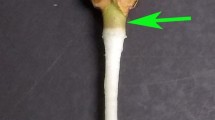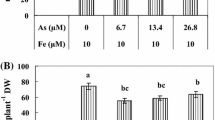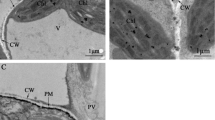Abstract
Scanning electron microscopic and energy-dispersive X-ray analyses were used to study the distributions of different types of elements in the epidermis, exodermis, endodermis, and vascular cylinder of the fracture face in the Lathyrus sativus L. roots in the presence or absence of Eu3+. Some index of the biological activity related to the elements binding with protein were determined also. The results showed that the tissular distributions of elements in the fracture face are different in the presence and absence of Eu3+. The atomic percentages of P, S, Ca, and Mn were influenced more than those of other elements. Eu3+ promoted the biological activities of various kinds of element. The one possible mechanism changing the biological activities was that the reaction of Eu3+ \(\mathop \to \limits^{ + e}\) Eu2+ would influence the electron capture or transport in elements of binding protein. Another mechanism was that CaM-Ca2+ becoming CaM-Eu3+ through Eu3+ instead of Ca2+ would affect the biological activity of elements by regulating the Ca2+ level in the plant cell.
Similar content being viewed by others
References
Y. Chen, X. Wang, Z. Ma, et al., Studies on Lathyrus sativus L., J. Lanzhou Univ. (Nat. Sci.) 16(2), 114–115 (1980) (in Chinese).
Department of Chemistry of Lanzhou University, The studies of the analysis of toxin and the method of removal toxin in Lathyrus sativus, J. Lanzhou Univ. (Nat. Sci.) 11(2), 45–65 (1975) (in Chinese).
S. L. N. Rao, P. R. Adiga, and P. S. Sarma, The isolation and characterization of β -N-oxalyl-L- α, β-diaminopropionic acid, a neurotoxin from the seeds of Lathyrus sativus, Biochemistry 3(3), 432–436 (1964).
Z. Li, W. Cai, Z. Xu, et al., The determination of ODAP in Lathyrus sativus using OPT colorimetry, J. Lanzhou Univ. (Nat. Sci.) 23(2), 130–132 (1987) (in Chinese).
X. Liu, G. Zhang, Y. Li, et al., Toxicological study on grass peavine (Lathyrus Sativus L.) and its toxic-component BOAA, Sci. Agric. Sin. 22(5), 86–93 (1989) (in Chinese).
J. Przybylska, Z. Zimniak-Przybylska, and P. Krajewski, Diversity of seed albumins in the grass pea (Lathyrus sativus L.): an electrophoretic study, Genet. Resources Crop Evol. 45, 423–431 (1998).
Z. Li, Y. Meng, L. Zhang, et al., Determination of α-and β-oxalyldiaminopropionic acid in Lathyrus sativus by electrophoresis, J. Lanzhou Univ. (Nat. Sci.) 28(3), 89–92 (1992) (in Chinese).
Y. An, F. Zeng, and R. Deng, Effect of europium on content of calcium in root of wheat, J. Chin. Rare Earth Soc. 17(1), 70–75 (1991) (in Chinese).
P. L. Stenponkus and F. O. Lanphear, Refinement of the triphenyl tetrazolium chloride method of determining cold injury, Plant Physiol. 42, 1423–1426 (1967).
M. M. Bradford, A rapid and sensitive method for the quantification of microgram quantities of protein utilizing the principle of protein-dye binding, Anal. Biochem. 72, 248–254 (1976).
F. Zeng, C. Yang, W. Hu, et al., Study of the physiological effects and applications of 1,4-disubstituted acyl thiosemicarbazide derivatives (DATCD) in plants: II. The effects of DATACD-A on the content of soluble protein in excised cucumber cotyledons, J. Lanzhou Univ. (Nat. Sci.) 24(3), 87–94 (1988) (in Chinese).
E. A. Talley and J. E. Mary, Extraction free amino acids, Am. Potato J. 65(1), 17–20 (1988).
A. Wang and G. Luo, Quantitative relation between the reaction of hydroxylamine and superoxide anion radicals in plants, Plant Physiol. Commun. 26(6), 55–57 (1990) (in Chinese).
M. G. Steiner and C. F. Babbs, Quantitation of the hydroxyl radical by reaction with dimethyl sulfoxide, Arch. Biochem. Biophys. 278(20), 478–481 (1990).
T. Brennan and C. Frenkel, Involvement of hydrogen peroxide in the regulation of senescence in pear, Plant Physiol. 59, 411–416 (1977).
H. E. Flores and A. W. Galson, Polyamines and plant stress: Activation of putrescine biosynthesis by osmotic shook, Science 17, 1259–1261 (1982).
J. F Ma and E. Takahashi, Effect of silicate on phosphate availability for rice in a P-deficient soil, Plant Soil. 133, 151–155 (1991).
E. Epstein. The anomaly of silicon in plant biology, Proc. Natl. Acad. Sci. USA 91(1), 11–17 (1994).
M. Beauregard L. Morin, and R. Popovic, Removal of the 33,23 and 18 K Da extrinsic proteins of photosystem II by sulfite tretment at alkaline pH, Biochem. Biophys. Res. Commun. vol. 152(2), 612–616 (1988).
M. G. Pitman, Transport across plant roots, Q. Rev. Biophys. 15(3), 481–554 (1982).
A. Trewavas and S. Gilroy, Signal transduction in plant cells, Trends Genet. 7(11–12), 356–361 (1991).
B. W. Poovaiah and A. S. N. Reddy, Calcium and signal transduction in plant, CRC Crit. Rev. Plant Sci. 12(3), 185–221 (1993).
P. Lamb, J. Haslam, L. Kessler, et al., Rapid activation of interferon-γ signal transduction pathway by inhibitors of tyrosine phosphatases, J. Interferon Res. 14(6), 365–373 (1994).
Y. Hou, L. Jing, and F. Zeng, The research on the effect of La3+ in the damage of wheat seedling leaves under drought stress, Acta Bot. Boreali-Occident. Sin. 21(6), 1134–1141 (2001) (in Chinese).
G. Drolet, E. B. Dumbroff, R. L. Legge, et al., Radical scavenging properties of polyamines, Phytochemistry 25(2), 367–372 (1986).
F. Zeng, P. Shing, M. Zheng, et al., Effect of lanthanum on ion absorption in cucumber seedling leaves, Biol. Trace Element Res. 78(3), 265–270 (2000).
Author information
Authors and Affiliations
Rights and permissions
About this article
Cite this article
Er Tian, H., Sheng Gao, Y., Min Li, F. et al. Effects of europium ions (Eu3+) on the distribution and related biological activities of elements in Lathyrus sativus L. roots. Biol Trace Elem Res 93, 257–269 (2003). https://doi.org/10.1385/BTER:93:1-3:257
Received:
Accepted:
Issue Date:
DOI: https://doi.org/10.1385/BTER:93:1-3:257




